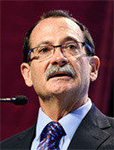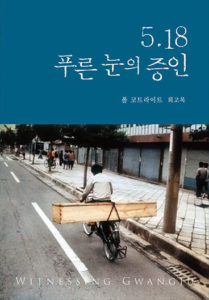Paul Courtright (South Korea) tells the world about the Gwangju Democratization Moment, 40 Years Later
Thanks for the ‘heads up’ from Steven Boyd Saum (Ukraine 1994-96)
Telling the world about the Gwangju Democratization Movement, 40 years later
Paul Courtright (South Korea 1979-81) witnessed the 1980 movement and wants to set the record straight amid current attempts to distort its history
for Hankyoreh by Kim Yong-hee, Gwangju correspondent

Courtright in front of a shelter for patients with Hansen’s disease, called hohyewon, in Naju, South Jeolla Province, in January 1980. (provided by Courtright)
From his arrival in South Korea in 1979 with the US Peace Corps until 1981, Paul Courtright, 66, took care of patients with Hansen’s disease (formerly known as leprosy) at a shelter called Hohyewon in Naju, South Jeolla Province.
On May 19, 1980, Courtright was at the Gwangju intercity bus terminal on a trip to Seoul when he saw armed soldiers from a special forces brigade beating a young man with clubs. Courtright wanted to step in, but he only watched, paralyzed by fear. Stricken with guilt for failing to help the man being clubbed, he made a call to Tim Warnberg, a colleague in Gwangju, on May 21. Courtright heard from his colleague that “something big” was going down in the city.
Since the buses weren’t running, Courtright rode his bike into Gwangju. Near the Songam neighborhood in Gwangju’s Nam (South) District, he saw a toppled bus next to a rice paddy. The bus was riddled with bullet holes and smeared with blood. Despite being aware of the seriousness of the situation, he courageously decided to stand with the people of Gwangju.
By this time, the US government had ordered American citizens to evacuate Gwangju, but that didn’t stop Courtright and other members of the Peace Corps. They thought that, if they stayed in Gwangju, the soldiers wouldn’t treat the citizens as harshly.

Courtright (second right) with journalist Jürgen Hinzpeter (far left) on the roof of Chonnam National University Hospital during the events of the Gwangju Democratization Movement of May 18, 1980. (provided by the May 18 Memorial Foundation)
Courtright and his colleagues provided interpretation for foreign correspondents like Jürgen Hinzpeter, and helped collect the bodies of the victims. When the martial law troops and the police temporarily vacated the downtown area, Courtright was worried whether order would be maintained, but the people of Gwangju came together to keep the community peaceful and orderly. In fact, he was touched to see how the citizens looked after the foreign Peace Corps Volunteers.
He realized to his horror that soldiers were persecuting innocent civilians in Gwangju. But most of the press were reporting that the citizens of Gwangju had been rioting. Determined to let the American government know the truth, Courtright made the difficult journey from Gwangju to Seoul on May 26, where he visited the US embassy, but no one was willing to sit down with him. Convinced that the American government had disregarded his story for political reasons, he made up his mind to tell the truth someday.
The first non-Korean to publish a firsthand account of the Gwangju Democratization Movement
On March 31st, the May 18 Memorial Foundation announced that the publisher Hollym was putting the finishing touches on Witnessing Gwangju, as Courtright’s memoir is titled, on the 40th anniversary of the events in Gwangju. The book is scheduled to be released simultaneously in South Korea and the US, in both Korean and English editions, on May 1.
In the introduction to his book, Courtright recalls an old woman during the uprising asking him to let the world know what was happening in Gwangju. While he hadn’t been able to keep his promise at the time, he says, he’s finally been able to face up to that responsibility now, 40 years later.
The book records what Courtright saw and heard over the course of 13 days in Seoul, Gwangju, and Naju, during May 1980, including democracy protests in Seoul on May 14, the martial law troops’ deployment to Gwangju on May 19, and his visit to the US embassy in Seoul on May 26. The book also includes unreleased photographs taken by Robin Moyer, a photographer for Time Magazine, which vividly convey the situation at the time.
Courtright drew upon his experience tending patients with Hansen’s disease in South Korea to become an ophthalmologist after returning to the US, later working in the area of public health in countries such as Egypt, Ethiopia, and South Africa. He also maintained his connection with Korea, delivering a lecture at Yonsei University in 2014 and serving as an advisor for Heart to Heart International, a welfare organization.

Paul Courtright
After stepping down as director of the Kilimanjaro Centre for Community Ophthalmology, in South Africa, in 2016, he visited Gwangju in May 2019. “The reason I wrote an account of the Gwangju Uprising is because I’d heard that the uprising was being distorted and disparaged in South Korea and I wanted to set the record straight,” he said.
Courtright had been planning to attend a ceremony marking the 40th anniversary of the Gwangju Uprising on May 18 this year, but it has reportedly been canceled because of the COVID-19 pandemic.
•
More about Paul and his memoir Witnessing Gwangju: A Memoir
Paul’s memoir covers 13 days in May 1980 when he was in Seoul then Gwangju.
The GwangjuUprising is viewed in Korea as the seminal moment for the demand for democracy in Korea. There are many academic pieces, some by Korea PCVs, about the uprising but his is the first memoir by a foreigner who was in Gwangju then. There were 5 PCVs trapped in Gwangju, when the Korean military re-took the surrounding areas and ringed Gwangju with tanks and soldiers. A few of these PCVs ended up translating for the foreign reporters who showed up. Paul ended up translating for Robin Moyer, a Time photographer. Some of his pictures, which had not been published before, are in the memoir.

The Korean edition of “Witnessing Gwangju.” (provided by Hollym Publishers)
At the time Paul was a leprosy worker, living in a small leprosy resettlement village just outside of Gwangju and in his memoir he shows what his life was like at that time. His initial intention, in writing the book, was to engage Americans in understanding this slice of Korean history and America’s response. When he returned to Korea last year, he was informed by his Korean friends that Koreans wanted a perspective of the events by a foreigner who witnessed them. He was viewed as being “objective” when the event has, over the last few years, become politicized
There is a Korean right-wing element saying that the massacre by the military either did not occur, or that the uprising was a North Korean plot, or that students and hooligans just rioted and the military had to bring order. None of this is true. In the back of the book, he decided to include copies of the cables from the US embassy in Seoul to the State Department which mention the PCVs, since there was criticism of them within the US Embassy when the uprising was going on.
•
Witnessing Gwangju: A Memoir
Paul Courtright (South Korea 1979–81)
Hollym
May, 2020

No comments yet.
Add your comment